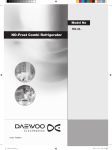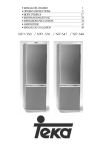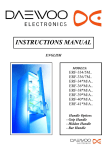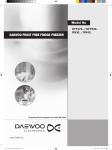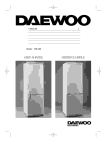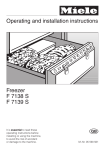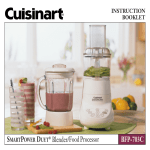Download Daewoo FR-024RBE Operating instructions
Transcript
REFRIGERATOR FR-024RBE WARNING / SAFETY PRECAUTIONS To avoid any risk of personal injury, material damage or incorrect use of the appliance, be sure to observe the following safety precautions. (After reading these owner’s instructions, please keep them in a safe place for reference). Remember to hand them over to any subsequent owner. Indicates that a danger of death or serious injury exists WARNING WARNING Do not plug several appliances into the same sockets. • This could cause overheating and the risk of fire. Keep the power plug away from the rear of the appliance. • A damaged power plug may cause fire due to overheating. Do not directly spray water inside or outside the appliance. • There is a risk of fire or electric shock. Do not spray water inside or outside the appliance. • There is a risk of explosion or fire. Do not bend the power cord excessively or place heavy articles on it. • This constitutes a fire hazard. If the power cord is damaged, have it replaced immediately by the manufacturer, its service agent or a similarly qualified person. Do not insert the power plug with wet hands. • You may receive an electric shock. Do not put a container filled with water on top of the appliance. • If the water spills on to any electrical parts, it may lead to fire or electric shock. Indicates that risk of personal injury or material damage exists CAUTION • Otherwise, there is a risk of electric shock. • Only the customer service may change the power cord and carry out any other repairs. Improper Installations and repairs may put the user at considerable risk. Be sure to earth the appliance. • Otherwise, it may cause material damage and electric shock. If you wish to dispose of the appliance, throw it away after removing the door or its seals. • In this way, it is not possible for a child to remain trapped inside it. Keep ventilation openings in the appliance enclosure or in the built-in structure, clear of obstruction. Do not use mechanical devices or other means to accelerate the defrosting process, other than those recommended by the manufacturer. Do not damage the refrigerant circuit. Do not use electrical appliances inside the food storage compartments of the appliance, useless they are of a type recommended by the manufacturer. Do not install the appliance in a damp place, where it could be splashed with water. • Incorrect insulation of the electrical parts may cause an electric shock or fire. Do not store volatile and flammable substances in the appliance. • The storage of benzene, thinner, alcohol, ether, LP gas or other such substances may cause an explosion. Do not disassemble, repair or alter the appliance. • It may cause fire or abnormal operations, which may lead to injury. Pull the power plug out of the socket before replacing the interior light in the appliance. 1 Caution Do not store too much food in the appliance. • When you open the door, an item may fall out and cause personal injury or material damage. Do not put bottles or any kind of glass in the appliance. • The container may break and cause personal injury. Caution The refrigerant used in appliances and the gases in the insulation material require special disposal procedures. Ensure that none of the pipes on the back appliance are damaged prior to disposal. If the wall socket is loose, do not insert the power plug. • It may cause electric shock or fire. DISPOSAL Do not disconnect the power cord by pulling on it. • You may disconnect a wire and cause a short circuit. Do not store article on top of the appliance. • When you open or close the door, the articles may fall and cause personal injury or material damage. Do not store pharmaceutical products, scientific material or other temperature-sensitive products in the refrigerator. • Products that require strict temperature controls must not be stored in the refrigerator. Do not let a child hang from the door. Remove any foreign matter from the power plug pins. • Otherwise, there is a risk of fire. Do not insert your hand into the bottom area of appliance. • Any sharp edges may cause personal injury. After unplugging the appliance, wait for at least five minutes before plugging it again to the wall socket. • Abnormal operation of the freezer may cause material damage. If the appliance is not be used for a long period of time, pull out the power plug. • Any deterioration in the insulation may cause fire. Do not let children touch or play with the control panel on the front of the appliance. • Do not allow children to play with this appliance. • Do not stand or lean on the base panel, pull-out parts, door and so on. • Repairs and maintenance of the appliance should only be performed by a qualified technician. Incorrect repairs by an unqualified person are a potential source of danger that may have critical consequences for the user of the appliance. Installing The Appliance 1. Allow an adequate space and install the appliance on a firm, level floor. • If the appliance is not level, there may be unusual noises and poor cooling. 2. Clean the appliance • Wipe and clean the inside and outside of appliance with a damp cloth. 3. Plug the appliance into a wall socket used exclusively by this appliance. • This appliance must be properly earthed. 4. Place the food in the appliance. • It is recommended that you wait for the appliance to cool for 3~4 hours before storing food in it. 5. Keep 60mm of space between the refrigerator and the back wall. • Insufficient space causes the noise of vibration, weakening of refrigerating power and the waste of electricity. • Overall space required in use. Refer to drawing and dimension as below. 10cm 10cm FR-024 6. The electrical plug must be accessible without moving the set. 7. For ambient temperature below 10 °C, the perfect performance of our refrigerator can not be achieved. 2 Caution Preparing The Appliance To Prepare your appliance for use and check that it is running correctly, take the following steps. Use of an earthed socket exclusively For the appliance : • If you are using a socket with an earthed terminal, you do not require a separate earthed connection. Use of a non-earthed socket : • Connect the “earthed wire” to the steel plate and bury it at depth of at least 25cm in the ground. 1. Install removed all shelves and compartments during transport in the correct positions. 2. Clean the appliance and accessories to remove any dust that accumulated during packing and shipping. 3. The interior light should be turned on when the appliance door’s opened 4. Set the temperature control to the coldest temperature and let the refrigerator operate for one hour. The appliance should get slightly chilled and the motor should run smoothly with a soft hum and no noise. Your appliance is operated by a compressor which switches “on and off” to maintain the internal temperature. When compressor is new, it requires running in for a period of up to five months. During this period, it may be slightly noisy. This is quite normal and does not represent a fault. LEVELING If the front of the appliance is slightly higher than the rear, the door can be opened and closed more easily. 5. Store food once the temperature in the appliance is sufficiently low. It takes a few hours after starting the appliance to reach the proper temperature. If the appliance does not operate correctly, check the electricity supply. If the problem persists, contact your dealer. 1. The appliance tilts down to the left. Turn the left adjusting leg in the direction of the arrow until the appliance is lever. 2. The appliance tilts down to the right. Turn the right adjusting leg in the direction of the arrow until the appliance is lever. 3 ABOUT THIS PRODUCT BEFORE CONNECTING TO THE MAINS The appliance compartment defrost manually. 1. Wait 2 hours after delivery before you connect the appliance to the power supply, in order to ensure troublefree operation. The electronic control panel or control knob enable you to control the temperature of appliance compartment. 2. Check the product label which locates appliance wall for voltage, refrigerant and other information. This is designed for domestic household use only. CAUTION : To prevent a child from being entrapped, keep out of reach of children and not in the vicinity of freezer (or refrigerator free-standing installation only. DO NOT USE EXTENSION CORD. Risk of electric shock. More tha one power supply. Disconnect all power supplies before servicing. 3. The socket should be easily accessible and not directly behind the appliance. 4. Electrical connections must be made in accordance with local regulations. The appliance must be earthed as described by law (connected through a properly earthed plug and socket). The manufacturer rejects all liability for injury to persons and animals or damage to property resulting from failure to comply with this requirement. 5. A 10A fuse or one of higher value must be used in the socket circuit. 6. If the appliance plug and the wall socket are incompatible, the socket must be replaced by a qualified electrician. 7. If the supply cord is damaged, it must be replaced by the manufacturer, his service agent or a similarly qualified person. 8. Do not use extension leads or multiple adapters, etc 4 DESCRIPTION OF YOUR REFRIGERATOR FR-024RBE 3 2 1 4 5 Ice box Adjustable shelves Leveling feet Thermostat control dial Bottle storage 5 Using the appliance This appliance is designed for domestic use only, specifically for the storage of edible foodstuffs. This appliance is designed to operate in ambient temperatures (surrounding air temperature) between 16°C and 43°C see the rating label. If these temperatures are exceeded i.e., colder or warmer, the appliance will not operate correctly. Should the amnient temperatures be exceeded for long periods, the temperature in the appliance will fall below 0°C and food spoilage may occur. The emperature will be affected by : • Room temperature • How often the door is opened • How much food is stored • Position of the appliance In determining the correct temperature control setting, all these factors have to be considered and some experimentation may be necessary Do not allow children to tamper with the controls or play with the product. Before Use Remove all securing tapes. Wash the inside of the appliance with lukewarm water with a little bicarbonate of soda added (5ml to 0.5 litre of water). Do not use soap or detergent as the smell may linger. Dry the appliance thoroughly. Thermostat Control Turning on the appliance and setting the thermostat in the fridge section. You switch on your appliance by connecting it to your mains supply and setting the thermostat. • The thermostat automatically regulates the temperature inside the refrigerator, depending on what number you have turned the thermostat control knob to. • Position <OFF> means that the appliance will not cool. However the light will still function. • Position <1> will give you a higher temperature inside the fridge. • Position <6> will give you a lower temperature inside the fridge. Do not use detergents, abrasive powders, highly perfumed cleaning products, wax polishes or products containing alcohol. To Start the Appliance 1. Allow the appliance to stand for 2 hours after installation. 2. Plug in the appliance and switch on at the mains supply. 3. Turn teh thermostat control to the required setting. A midway setting is usually suitable for normall operation (see themostat control). 4. Leave the appliance for approximately 4 hours for the correct temperature to be reached before placing food inside. OFF • Ideally the thermostat should be set to position <3> or <4>. • IMPORTANT : The ambient temperature of the room, the temperature of food and the a mount of food that has been placed in the appliance and how often the door is opened, will all affect the temperature being maintained by the appliance. • On the maximum setting (position <6>), your fridge will work harder to maintain a lower temperature and will increase the energy usage. There is no need to run your appliance on this setting for prolonged periods and you should return the thermostat knob to position <3> or <4>. 6 1 5 2 4 3 COLDER 6 DISCONNECTION Electrical disconnection : remove the plug from the mains, or (if applicable) disconnect the two-pole circuit breaker upstream from the socket. PROTECTING THE ENVIRONMENT - The packaging may be completely recycled, as confirmed by the recycling symbol; follow local disposal regulations. Keep room dry and well ventilated. Keep more than 2inches distance space at the top for ventilation. Clean interior with a damp cloth. Best room temperature Range +16 °C to 43 °C - The appliance is manufactured form reusable materials. - When you decide to scrap this product, please check the cable to be disconnected from the mains. Then cut off the cable and dispose of the product according to local waste disposal laws. - This product is free of CFC’s (cooling circuit contains R134a or R-600a). This use R-600a or R134a as a refrigerant. Check the compressor label on the rear of the appliance or the rating label inside the fridge to see which refrigerant is used for your appliance. IMPORTANT 1. Although this product was carefully checked before packing. Please check the product for damage and for correct closing of the doors. Complaints must be reported to your retailer within 24 hours of delivery. • Wait 2 hours before connecting to the mains 2. Installation instructions (7 drawings below) 3. Keep potentially hazardous packing materials (plastic bags, etc.) out of reach of children to prevent the risk of trapping and suffocation. GENERAL RECOMMENDATION Check for damages and correct closing of the doors. Not in the vicinity of a heat source. No glass bottles in the freezer compartments. The bottles might burst. 7 NOTES ON FOOD STORAGE This is general information for food storage : 1. Follow storage times indicated by the frozen food manufacturer. Make sure that the packaging is undamaged. 2. Save energy : minimize opening of the door by storing identical food items together. Ice cubes and ice lollies straight out of the freezer are too cold for consuming. They may cause ‘cold’ burns. Do not allow children to play or hide in the refrigerator to prevent the risk of trapping and suffocation. 3. Items suitable for freezing : meat, poultry, fresh, fish, vegetables, fruits, dairy products, bread, baked, goods, pre-cooked meals. 4. Items not suitable for freezing : lettuces, radishes, grapes, whole apples and pears, fatty meats. 5. When you freeze food yourself, pack it in appropriate quantities. In order to freeze food right through do not exceed the following quantities to best preserve the quality : - fruits and vegetables : up to 1kg, - meat : up to 2.5kg. Always unplug before cleaning and servicing. If the power cord is damaged, it must be replaced by the manufacturer or its service agent or a similarly qualified person in order to avoid a hazard. 6. Blanch vegetables after washing and cutting them. (2-3 minutes in boiling water; then quickly cool them down in cold water. When you use a steamer or microwave oven, follow the operating instructions). 7. Keep packs dry in order to avoid them freezing together. 8. Freeze fresh food separately form already frozen foods. 9. Do not salt or season fresh food or blanched vegetables before freezing. Other foods may be lightly salted or seasoned. The intensity of flavor of some spices can change. 10. Use materials or containers specially suitable for freezing in order to avoid loss of quality. 11. Write contents and date of freezing on the packs. Do not exceed the storage time indicated in order to preserve quality. 12. Do not freeze bottles or cans with carbonated drinks, cause they might burst. 13. Take out as much food as is immediately required for thawing. Prepare it as soon as possible after thawing. 14. If you open the door more than one minute, the bell rings every one minute during five minutes 15. Do not block air vents with food. Do not file the inside up. It can interfere with cold air circulation. 16. It could be necessary to reduce the quantity to be frozen if freezing every day is anticipated. 17. Food to be frozen is not to be placed in direct contact with food in storage. 18. Do not place watery food close to the cold air ducts. 19. The freezer basket(Case F “C”) is essential for refrigerating performace. Do not move it away from refrigerator. 8 WHEN PURCHASING FROZEN FOOD TROUBLESHOOTING GUIDE This is general information for food storage : 1. Make sure that the packaging is undamaged (damage may have caused the food to deteriorate). Bulging packs or packs which are marked with liquid stains could have been improperly stored and may have been partially thawed. 2. Leave frozen food purchases until last and transport the items in insulated bags. 3. Place the items in the freezer as soon as possible. 4. Do not refreeze partially thawed food. Consume it within 24 hours. 5. Observe the date of consumption and storage information. 1. The appliance does not work. Check : - power failure, - properly inserted plug, - (if applicable) connection of the two-pole circuit breaker, - damage to the mains lead, - correct setting of the temperature controls. 2. The temperature inside the compartments is not low enough, Check for : - closure of the doors, - installation near a heat source, - correct setting of the freezer control knob, - inhibited air circulation. 3. The refrigerator compartment temperature is too low. Check for : - correct setting of the temperature controls. 4. The internal light does not work, if applicable Refer to point 1 and then : - unplug the appliance from the mains. - check the bulb and replace if necessary (max.25W) - to change the lamp, first remove the window of the lamp by pulling upper part forward. - take out the lamp and replace it for a new one. - finally set again window lamp on its place. CLEANING 1. Always disconnect the appliance from the mains supply. 2. Do not use abrasives. Periodically clean with a sponge dampened in lukewarm water. A neutral pH detergent may be used. Rinse and dry with a soft cloth. 3. Wipe the outside with a soft cloth dampened in water. 4. Periodically clean the front grille and the radiator at the back with a vacuum cleaner or a brush. 5. Any increase in temperature of frozen food during cleaning the refrigerator can shorten its storage life. PROLONGED DISUSE 1. Empty the refrigerator compartments. 2. Unplug the appliance from the mains. 3. Clean and dry both compartments. 4. Leave the doors open to prevent the formation of unpleasant odors. AFTER SALES SERVICE APPLIANCE PACKAGING INFORMATION All material are environmentally sound! They can be dumped or burned at an incineration plant without danger! About the materials : The plastics can be recycled and are identified as follows : PE : for polyethylene, e.g. the outer covering and the bags in the interior. PS : for polystyrene foam, e.g. the pads, which are all free of chlorofluorocarbon. The carton parts are made from recycled paper and should be disposed of at a waste-paper recycling collection location. Before contacting our After Sales Service Department: 1. Try to remedy the problem (please read section “trouble shooting guide”). 2. Restart the appliance to check whether the fault repeats. If the malfunction persists, switch off the appliance and try again after an hour. 3. If the malfunction still persists, then contact our Customer Service, specifying : - the nature of the problem, - the appliance model number, - your full address, telephone number and area code. Note : door opening direction changes carried out by our Customer Service are not covered by the terms of guarantee. 9 DISPOSAL OF OLD APPLIANCES For environmental reasons, refrigeration appliances must be disposed of properly. This applies to your old appliance, and –at the end of its service life-for your new appliance as well. Warning! Before disposing of old appliances make them remove or destroy any snap or latch closures. This eliminates the danger that playing children lock themselves into the appliance (danger of suffocation!) or place themselves into other life-endangering situations. Disposal : • The appliance may not be disposed of with domestic waste or bulky refuse. • The refrigerant circuit, especially the heat exchanger at back of the appliance, may not be damaged. • Information concerning collection schedules or locations can be obtained from the local disposal authorities or town hall. Disposal of Used Electrical & Electronic Equipment The meaning of the symbol on the product, its accessory or packaging indicates that this product shall not be treated as household waste. Please, dispose of this equipment at your applicable collection point for the contains fluorinated greenhouse gases covered By the Kyoto Protocol and is hermetically sealed. Recycling of electrical & electronic equipments waste. In the European Union and Other European countries which there are separate collection systems for used electrical and electronic product. By ensuring the correct disposal of this product, you will help prevent potentially hazardous to the environment and to human health, which could otherwise be caused by unsuitable waste handling of this product. The recycling of materials will help conserve natural resources. NOTICE The lamp and the alarm of the refrigerator can be switched off even though the doors are not completely closed, if applicable Note : The edge of the appliance door and the front side of the appliance cabinet may be hot. This is normal and intended to prevent the formation of condensation. Gurgling noises etc. inside the refrigerating circuit are normal. 10 Please do not therefore dispose of your old electrical and electronic equipment with your household waste. For more detailed information about recycling of this product, please contact your local city office, your household waste disposal service or the shop where you purchased the product. REVERSING THE DOOR SWING REVERSING Caution : To avoid injury to yourself and / or property, we recommend someone assist you during the door reversal process. • Ensure the appliance is unplugged and empty • Adjust the two leveling feet to their highest position. • We recommend you have someone to assist you. Tools required • Cross-bladed screw driver Tools required To take the door off it is necessary to tilt the appliance backward. You should rest the appliance on something solid e.g. a chair just below the top panel so you can access the bottom of the refrigerator. DO NOT lay the appliance completely flat as this may damage the coolant system. 11














